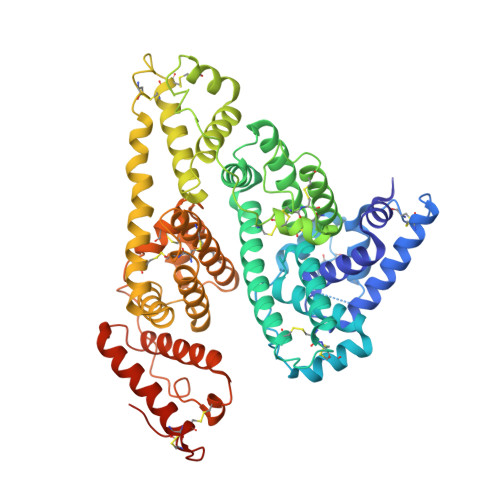Interaction of Benzbromarone with Subdomains IIIA and IB/IIA on Human Serum Albumin as the Primary and Secondary Binding Regions.
Yamasaki, K., Kawai, A., Sakurama, K., Udo, N., Yoshino, Y., Saito, Y., Tsukigawa, K., Nishi, K., Otagiri, M.(2021) Mol Pharm 18: 1061-1070
- PubMed: 33478218
- DOI: https://doi.org/10.1021/acs.molpharmaceut.0c01004
- Primary Citation of Related Structures:
7D6J - PubMed Abstract:
Benzbromarone has been used for the treatment of gout for more than 30 years. Although it shows a high level of binding to plasma proteins (>99%), our knowledge of this binding is not sufficiently extensive to permit us to understand its pharmacokinetics and pharmacodynamics. To address this issue in more detail, we characterized the binding of benzbromarone to human serum albumin (HSA), the most abundant protein in plasma. Equilibrium dialysis and circular dichroism findings indicated that benzbromarone binds strongly to one primary as well as to multiple secondary sites on HSA and that the bromine atoms of benzbromarone play important roles in this high affinity binding. An X-ray crystallographic study revealed that benzbromarone molecules bind to hydrophobic pockets within subdomains IB, IIA, and IIIA. Inhibition experiments using site specific ligands (subdomain IB; fusidic acid, IIA; warfarin, IIIA; diazepam) indicated that the primary and secondary binding sites that benzbromarone binds to are within subdomains IIIA and IB/IIA, respectively. Lastly, a study of the effect of fatty acids on the benzbromarone-HSA interaction suggested that benzbromarone, when displaced from subdomain IIIA by sodium oleate, could transfer to subdomains IB or IIA. Thus, these data will permit more relevant assessments of the displacement interactions of benzbromarone especially in cases of co-administered drugs or endogenous compounds that also bind to subdomain IIIA. In addition, the findings presented herein will also be useful for designing drug combination therapy in which pharmacokinetic and pharmacodynamic performance need to be controlled.
Organizational Affiliation:
Faculty of Pharmaceutical Sciences, Sojo University, Kumamoto 860-0082, Japan.















